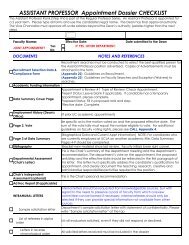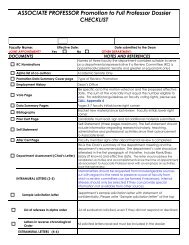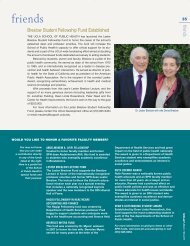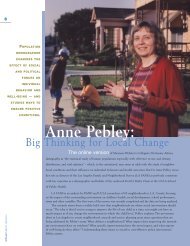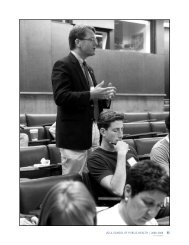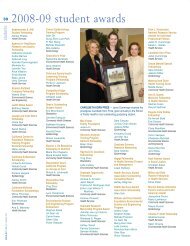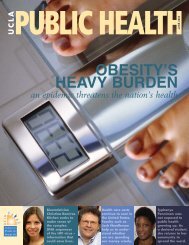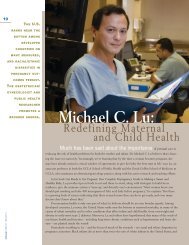A BROADER VIEWOF HEALTH: - UCLA School of Public Health
A BROADER VIEWOF HEALTH: - UCLA School of Public Health
A BROADER VIEWOF HEALTH: - UCLA School of Public Health
Create successful ePaper yourself
Turn your PDF publications into a flip-book with our unique Google optimized e-Paper software.
Pew Charitable Trust, Cole and his <strong>UCLA</strong> <strong>School</strong><br />
<strong>of</strong> <strong>Public</strong> <strong>Health</strong> colleagues are working to ensure<br />
that health concerns are addressed in the environmental<br />
impact report for the Wilshire Corridor<br />
Transit Alternatives – the so-called Subway-to-the-<br />
Sea proposed to be built on Los Angeles’ Westside.<br />
Beyond addressing health concerns, Cole says, the<br />
<strong>UCLA</strong> group is seeking to maximize potential health<br />
benefits from the development: how, for instance,<br />
the system might be able to tap into existing pedestrian<br />
and bicycle routes to encourage people to<br />
walk and bike more. In addition, with funding from<br />
Robert Wood Johnson Active Living Research, the<br />
<strong>UCLA</strong> group is conducting rapid HIAs around<br />
physical activity in schools.<br />
HIAs related to proposed developments – from<br />
a new shopping center to a new highway or subway<br />
system – are a natural fit, Cole explains, since they<br />
can be coupled with environmental impact assessments.<br />
But he and others have also been grappling<br />
with the more challenging but no-less-important<br />
type <strong>of</strong> HIA, ones attached to policies that don’t<br />
involved bricks-and-mortar projects. “The question<br />
is how we get people thinking about the upstream<br />
determinants <strong>of</strong> public health in labor, energy or<br />
agricultural policies, for example,” Cole says.<br />
Much <strong>of</strong> the work <strong>of</strong> the <strong>UCLA</strong> HIA project<br />
has involved building the tools and evidence base<br />
for agencies to apply to these population-level HIAs.<br />
In 2008, Cole and Fielding co-wrote a white paper<br />
published by the Partnership for Prevention on how<br />
Congress and federal agencies could incorporate<br />
HIAs into large-scale policy-making (“Building<br />
<strong>Health</strong> Impact Assessment Capacity: A Strategy<br />
for Congress and Government Agencies”).<br />
Beyond the formal processes <strong>of</strong> analyzing<br />
the potential impacts <strong>of</strong> a project or policy, Cole<br />
Promoting decent,<br />
affordable housing<br />
reduces problems<br />
associated with allergens,<br />
increases community<br />
stability and improves<br />
mental health,<br />
to name a few.<br />
explains, the HIA as well as other tools can play<br />
a broader role by simply educating the public and<br />
policy-makers about the connections between decisions<br />
that are not primarily about health and their<br />
potential public health impacts.<br />
Indeed, notes Fielding, the HIA isn’t an end<br />
in itself. “The HIA is a tool for operationalizing and<br />
concretizing the <strong>Health</strong> in All Policies concept,” he<br />
says. “But it does nothing unless it’s coupled with<br />
efforts to use that information to educate those<br />
who are making policy about why they should pay<br />
more attention to the health impacts <strong>of</strong> decisions<br />
in other sectors.”<br />
Kominski points out that the <strong>Health</strong> in All<br />
Policies movement is based on a notion that has long<br />
been recognized in public health – and championed<br />
by <strong>UCLA</strong> <strong>School</strong> <strong>of</strong> <strong>Public</strong> <strong>Health</strong> faculty including<br />
Dr. Lester Breslow, dean emeritus <strong>of</strong> the school.<br />
“In public health we know that the medical care<br />
delivery system is just one determinant <strong>of</strong> the population’s<br />
health – an important component, but a<br />
relatively small one, especially when you consider<br />
the cost,” Kominski says. “There are also social<br />
determinants <strong>of</strong> health, and we are likely to reap<br />
much greater health improvements from investments<br />
in those areas than from additional medical<br />
care expenditures.”<br />
Fielding believes many outside <strong>of</strong> public health<br />
are beginning to come around to that point <strong>of</strong> view.<br />
“When we’re spending 50-100 percent more than<br />
our developed-country trading partners and doing<br />
worse in terms <strong>of</strong> health, it becomes obvious that<br />
we can’t just work through the medical care system<br />
to improve health,” he says. “We won’t move from<br />
being 37th in the world in life expectancy until the<br />
determinants <strong>of</strong> health and health impacts <strong>of</strong> decisions<br />
become a focus <strong>of</strong> public policy at all levels.”<br />
15<br />
cover story <strong>UCLA</strong>PUBLIC <strong>HEALTH</strong>



